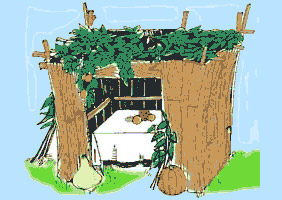|
|
|

Holiday: Sukkot
Sukkot - the four species
"And ye shall take... thee fruit of goodly trees, branches of palm trees and boughs of thick trees, and willow of the brook and ye shall rejoice before the L-rd your G-d seven days" (Lev. 23:40).
On Succot we are commanded to "take the four species" - and etrog (citron), hadasim (myrtle twigs), the lulav (palm branch) and aravot (willow).
We arrange the lulav as follows:
1. Arrange the thick middle stem (spine) of the lulav, so that it faces the individual.
2. Place three hedasim in the holder on the right side of the lulav.
3. Place two aravot in the holder on the left side of the lulav.
4. The hadasim should be higher than the aravot.
The lulav should be held in the right hand with the middle stem facing the individual. The etrog should be held in the left hand. While blessing/s are being recited, the etrog is held against the lulav with the pittum pointing downwards.
Immediately upon the completion of the blessing/s the etrog is to be turned so the pittum is pointing upward and held firm against the aravot or aravot holder on the 1ulav. Care should be taken that the etrog should not be held against a low point of the aravot holder where the aravot might not reach.
The lulav and etrog, held together, should then be shaken in all directions, front, side, other side, up and down. This symbolizes G-d's presence in all directions. Two blessings are recited on the first day of Succot and one blessing on the remaining seven days of Succot. The blessings can be found in the Siddur.
|
|
|
SUCCAH BUILDING REMINDERS:
1. When constructing a succah, the sechach covering should not be placed on the succah until the walls of the succah are set up and firmly secured.
2. Before one builds a succah one should examine the area above the intended location of the succah to determine if anything (i.e. tree branches) will be hanging over the top of the succah. If such is the case, consult with Rabbi Segal as to how this might affect the validity of the succah.
3. If the walls of your succah are made out of canvas or cloth, be sure to tie down such material tightly against the frame.
4. Succah decorations that are hung beneath the sechach of the succah should preferably be placed within one foot of the sechach. If this cannot be done, conult with Rabbi Segal as to parameters involved in maintaining a valid succah.
5 Enough sechach should be placed on the top of the succah to cover the majority of the roof area and should provide shade for the majority of the floor of the succah.
If you have any questions regarding the building of a succah, do not hesitate to contact Rabbi Segal.
|
|



